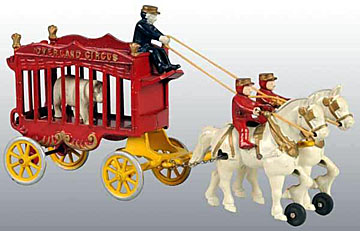
ANSWER: At the turn of the 20th century, the Kenton Hardware Company promoted itself as "the largest factory in the USA exclusively making cast iron toys." The factory produced a variety of toys that were miniature versions of fire engines, circus wagons, carriages, banks, trains, and stoves. From the 1890's to the 1950's, the town of Kenton, Ohio, was a center of American cast-iron production.

Perkins didn’t begin manufacturing toys until 1894 when a series of patent disputes caused Perkins to change the name of his company from the Kenton Lock Manufacturing Company to the Kenton Hardware Manufacturing Company. Kenton’s line consisted of banks, horse-drawn vehicles, and stoves. The production of the Columbia Bank, a souvenir of the World's Columbian Exposition, which provided a successful launch into the U.S. toy market.
What followed was a wide range of toy vehicles—hansom cabs, sulkies, surreys, chariots, fire-patrol carts, sedans, racing cars, buses, blimps, air-planes, milk wagons, bakery wagons, bandwagons, dump trucks, lumber trucks and circus trucks. Also, mechanical and regular banks in the forms of teddy bears and polar bears, the Statue of Liberty, the Flatiron building, radios and other playthings such as cap pistols, ranges and miniature sadirons.

Like most other businesses, the Kenton Hardware Company suffered during the Great Depression, so much so that it was in danger of going bankrupt. Then, just as Shirley Temple saved the Ideal Toy Company and Mickey Mouse did the same for Lionel trains and Ingersol watches, another popular icon came to the rescue of Kenton. Gene Autry saved the day with the Gene Autry toy pistol.
Vice president William Bixler persuaded the company to manufacture a copy of Gene Autry’s pearl handled six-shooter. Autry sent one of his guns to Ohio to assist in the creation of a child’s size model. Joe Solomon made the master mold in 1938. By 1939, over two million Gene Autry Repeating Cap Pistols had been sold.

The peak of cast-iron toy production extended from shortly before the turn of the 20th century until the 1940's, when lighter-weight models that were less expensive to produce and transport superseded them. Kenton ceased production of horse-drawn toys in the early 1920's, except for a beer wagon made in the 1930's, but in 1939 the firm introduced a completely new line of horse-drawn toys, which continued through the early 1950's.

Kenton ceased operations in 1952.
To read more articles on antiques, please visit the Antiques Articles section of my Web site. And to stay up to the minute on antiques and collectibles, please join the over 30,000 readers by following my free online magazine, #TheAntiquesAlmanac. Learn more about the "Antiques of Christmas" in the 2021 Holiday Edition, online now. And to read daily posts about unique objects from the past and their histories, like the #Antiques and More Collection on Facebook.





